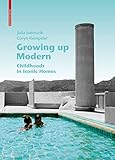Growing up Modern : Childhoods in Iconic Homes / Julia Jamrozik, Coryn Kempster.
Material type: TextPublisher: Basel : Birkhäuser, [2021]Copyright date: ©2021Description: 1 online resource (328 p.)Content type:
TextPublisher: Basel : Birkhäuser, [2021]Copyright date: ©2021Description: 1 online resource (328 p.)Content type: - 9783035619058
- 9783035620313
- Architecture, Domestic -- History -- 20th century
- Dwellings -- Psychological aspects
- Modern movement (Architecture)
- Hans Scharoun
- House Schminke
- Ikonen der Moderne
- Oral History
- Unité d'Habitation
- Villa Tugendhat
- Weissenhofsiedlung
- ARCHITECTURE / History / Contemporary (1945-)
- Modernity, Oral history, 20th-century icons, Unité d'habitation, Villa Tugendhat, Weissenhof estate, Schminke house
- 720.9
- online - DeGruyter
- Issued also in print.
| Item type | Current library | Call number | URL | Status | Notes | Barcode | |
|---|---|---|---|---|---|---|---|
 eBook
eBook
|
Biblioteca "Angelicum" Pont. Univ. S.Tommaso d'Aquino Nuvola online | online - DeGruyter (Browse shelf(Opens below)) | Online access | Not for loan (Accesso limitato) | Accesso per gli utenti autorizzati / Access for authorized users | (dgr)9783035620313 |
Frontmatter -- Contents -- Quote -- Architecture and Personal Narrative -- Weissenhof Estate Row House. J. J. P. Oud —Stuttgart, Germany, 1927 -- Tugendhat House. Ludwig Mies van der Rohe —Brno, Czech Republic, 1930 -- Schminke House. Hans Scharoun—Löbau, Germany, 1933 -- Unité d’Habitation. Le Corbusier—Marseille, France, 1952 -- Lessons from Childhoods in Iconic Homes -- Acknowledgments -- About the Authors -- Illustration Credits -- Index
restricted access online access with authorization star
http://purl.org/coar/access_right/c_16ec
What was it like to grow up in a Modernist residence? Did these radical environments shape the way that children looked at architecture later in life? The oral history in this book paint a uniquely intimate portrait of Modernism.The authors conducted interviews with people, who spent their childhood in radical Modernist domestic spaces, uncovering both serene and poignant memories. The recollections range from the ambivalence of philosopher Ernst Tugendhat, now 90 years old, who lived in the famous Mies van der Rohe house in Brno (1930) to the fond reminiscing of the youngest daughter of the Schminke family, who still dreams of her Scharoun-designed ship-like villa in Löbau (1933). The book offers a unique, private and often refreshing perspective on these icons of the avant-garde.
Wie war die Erfahrung, in einem Bau der Moderne aufzuwachsen? Wie hat diese radikal andere Umgebung die Kinder und späteren Erwachsenen geprägt? Dieses Buch zeichnet ein intimes und ungewöhnliches Porträt der Architektur der Avantgarde.Die Autoren haben „Oral History"-Interviews mit ehemaligen Bewohnern geführt und dabei heitere wie auch ergreifende Erinnerungen aufgezeichnet. Oft dauerte das glückliche Familienleben in diesen Häusern nur kurze Zeit - der Philosoph Ernst Tugendhat, heute 90 Jahre alt, musste mit acht Jahren das berühmte Haus Tugendhat von Mies van der Rohe (1930) verlassen und die von Scharoun entworfene, schiffsartige Villa Schminke (1933) wurde von der Familie nur ein Jahr lang zusammen bewohnt. Das Buch bietet eine einzigartige und erfrischende Perspektive auf Ikonen der modernen Architektur.
Issued also in print.
Mode of access: Internet via World Wide Web.
In English.
Description based on online resource; title from PDF title page (publisher's Web site, viewed 01. Dez 2022)


